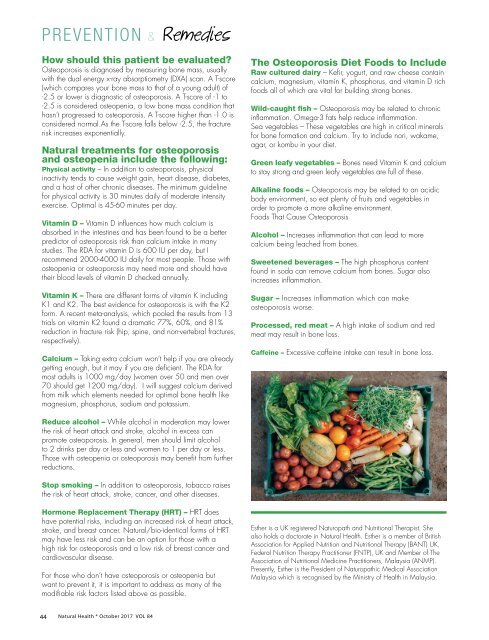Natural Health October 2017
Create successful ePaper yourself
Turn your PDF publications into a flip-book with our unique Google optimized e-Paper software.
PREVENTION & Remedies<br />
How should this patient be evaluated?<br />
Osteoporosis is diagnosed by measuring bone mass, usually<br />
with the dual energy x-ray absorptiometry (DXA) scan. A T-score<br />
(which compares your bone mass to that of a young adult) of<br />
-2.5 or lower is diagnostic of osteoporosis. A T-score of -1 to<br />
-2.5 is considered osteopenia, a low bone mass condition that<br />
hasn’t progressed to osteoporosis. A T-score higher than -1.0 is<br />
considered normal.As the T-score falls below -2.5, the fracture<br />
risk increases exponentially.<br />
<strong>Natural</strong> treatments for osteoporosis<br />
and osteopenia include the following:<br />
Physical activity – In addition to osteoporosis, physical<br />
inactivity tends to cause weight gain, heart disease, diabetes,<br />
and a host of other chronic diseases. The minimum guideline<br />
for physical activity is 30 minutes daily of moderate intensity<br />
exercise. Optimal is 45-60 minutes per day.<br />
Vitamin D – Vitamin D influences how much calcium is<br />
absorbed in the intestines and has been found to be a better<br />
predictor of osteoporosis risk than calcium intake in many<br />
studies. The RDA for vitamin D is 600 IU per day, but I<br />
recommend 2000-4000 IU daily for most people. Those with<br />
osteopenia or osteoporosis may need more and should have<br />
their blood levels of vitamin D checked annually.<br />
Vitamin K – There are different forms of vitamin K including<br />
K1 and K2. The best evidence for osteoporosis is with the K2<br />
form. A recent meta-analysis, which pooled the results from 13<br />
trials on vitamin K2 found a dramatic 77%, 60%, and 81%<br />
reduction in fracture risk (hip, spine, and non-vertebral fractures,<br />
respectively).<br />
Calcium – Taking extra calcium won’t help if you are already<br />
getting enough, but it may if you are deficient. The RDA for<br />
most adults is 1000 mg/day (women over 50 and men over<br />
70 should get 1200 mg/day). I will suggest calcium derived<br />
from milk which elements needed for optimal bone health like<br />
magnesium, phosphorus, sodium and potassium.<br />
The Osteoporosis Diet Foods to Include<br />
Raw cultured dairy – Kefir, yogurt, and raw cheese contain<br />
calcium, magnesium, vitamin K, phosphorus, and vitamin D rich<br />
foods all of which are vital for building strong bones.<br />
Wild-caught fish – Osteoporosis may be related to chronic<br />
inflammation. Omega-3 fats help reduce inflammation.<br />
Sea vegetables – These vegetables are high in critical minerals<br />
for bone formation and calcium. Try to include nori, wakame,<br />
agar, or kombu in your diet.<br />
Green leafy vegetables – Bones need Vitamin K and calcium<br />
to stay strong and green leafy vegetables are full of these.<br />
Alkaline foods – Osteoporosis may be related to an acidic<br />
body environment, so eat plenty of fruits and vegetables in<br />
order to promote a more alkaline environment.<br />
Foods That Cause Osteoporosis<br />
Alcohol – Increases inflammation that can lead to more<br />
calcium being leached from bones.<br />
Sweetened beverages – The high phosphorus content<br />
found in soda can remove calcium from bones. Sugar also<br />
increases inflammation.<br />
Sugar – Increases inflammation which can make<br />
osteoporosis worse.<br />
Processed, red meat – A high intake of sodium and red<br />
meat may result in bone loss.<br />
Caffeine – Excessive caffeine intake can result in bone loss.<br />
Reduce alcohol – While alcohol in moderation may lower<br />
the risk of heart attack and stroke, alcohol in excess can<br />
promote osteoporosis. In general, men should limit alcohol<br />
to 2 drinks per day or less and women to 1 per day or less.<br />
Those with osteopenia or osteoporosis may benefit from further<br />
reductions.<br />
Stop smoking – In addition to osteoporosis, tobacco raises<br />
the risk of heart attack, stroke, cancer, and other diseases.<br />
Hormone Replacement Therapy (HRT) – HRT does<br />
have potential risks, including an increased risk of heart attack,<br />
stroke, and breast cancer. <strong>Natural</strong>/bio-identical forms of HRT<br />
may have less risk and can be an option for those with a<br />
high risk for osteoporosis and a low risk of breast cancer and<br />
cardiovascular disease.<br />
For those who don’t have osteoporosis or osteopenia but<br />
want to prevent it, it is important to address as many of the<br />
modifiable risk factors listed above as possible.<br />
Esther is a UK registered Naturopath and Nutritional Therapist. She<br />
also holds a doctorate in <strong>Natural</strong> <strong>Health</strong>. Esther is a member of British<br />
Association for Applied Nutrition and Nutritional Therapy (BANT) UK,<br />
Federal Nutrition Therapy Practitioner (FNTP), UK and Member of The<br />
Association of Nutritional Medicine Practitioners, Malaysia (ANMP).<br />
Presently, Esther is the President of Naturopathic Medical Association<br />
Malaysia which is recognised by the Ministry of <strong>Health</strong> in Malaysia.<br />
44 <strong>Natural</strong> <strong>Health</strong> * <strong>October</strong> <strong>2017</strong> VOL 84

















